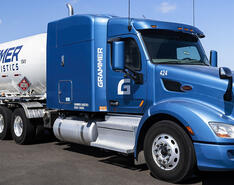Editor's Note: A version of this article was first published in the National Propane Gas Association's Bobtail.
The Department of Transportation, Maritime Administration is now accepting applications to support port infrastructure development and improvements through the FY 2025 Port Infrastructure Development Program (PIDP). States, counties, cities, and federally recognized tribes, are eligible to receive between $1 million and $150 million per award to improve the safety, efficiency or reliability of the movement of goods through ports and intermodal connections to ports.
This includes the purchase of equipment and infrastructure to aid in the movement and loading of goods, such as by forklifts, container terminal tractors or support vehicles, as well as to supply power onshore through propane generators.
For propane, the biggest takeaways are that projects supporting the following activities are not only allowable, but encouraged:
- Installation of port bunkering facilities from ocean-going vessels for fuels such as LPG
- Harbor craft or equipment replacements or retrofits
- Development of port or terminal microgrids, including backup generators and power sources—and their fueling
- Purchase of cargo handling equipment and related infrastructure such as terminal tractors, forklifts, trucks, and more.
Bunkering is especially important to the Trump Administration, which has worked hard to expand hydrocarbon infrastructure at home and abroad during the first six months in office with increased permitting for site development and encouraging projects like the Panama LPG pipeline. With rising exports bringing economic prosperity to the heartland, large LPG suppliers and bunker manufacturers alike should take notice and encourage their states and cities to include bunker development in their plans.
With EV mandates and subsidies stripped at the federal level, port authorities are going to need alternative options to transport the hundreds of millions of tons of cargo flowing in and out of our waterways. This is critical for applicants reevaluating the role of EVs in their projects—as such, development-phase activities will be eligible under the FY 25 PIDP, including planning, feasibility analysis, revenue forecasting, environmental review, permitting, and preliminary engineering and design work.
Propane remains the cleanest, quietest, and cheapest fuel source to ensure clean air, water, and working conditions at ports. Forklifts, cargo tractors, local truck fleets, and even pilot craft all run on propane at a fraction of the cost of diesel and gasoline, without the extensive maintenance and refueling challenges of EVs, especially in harsh weather conditions and where electric grids are already strained. Propane is listed as an alternative fuel under the Clean Air Act and modern low-nitrogen oxide (NOx) propane engines are up to 90% cleaner than EPA standards, emitting up to 96% fewer NOx emissions than diesel and nearly zero particulate matter emissions. Port Newark Container Terminal’s propane tractors have reduced NOx emissions by 99%, total hydrocarbon idle emissions by 77.5%, carbon dioxide emissions by 14%, and total particulate matter to an almost undetectable level.
The FY 25 PIDP application window closes September 10th, so act now to incorporate propane into your port’s development plans.

